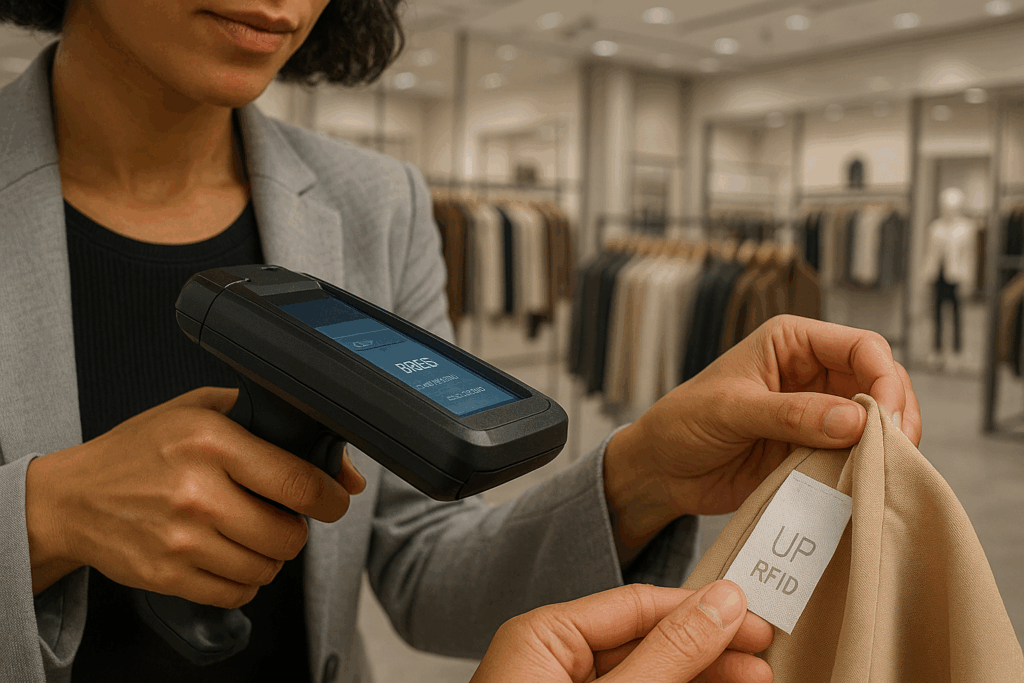RFID portals are transforming the way major retailers manage assets at scale. By replacing manual processes with automated scanning, this technology eliminates rework, reduces losses, and ensures real-time visibility — even for audits.
But how does this work in practice? And what role does it play in asset governance for companies managing thousands of moving items?
In this article, you’ll learn:
- What an RFID portal is and how it works
- The most common types and use cases
- How it ensures asset compliance
- Real-world results in decentralized operations
- Why RFID portals are a turning point for retail asset management
Table of Contents
ToggleThe Urgency of Asset Control in Retail: Risks You Can’t See in a Spreadsheet
Retail chains face a recurring challenge: managing thousands of fixed assets across multiple locations with constant movement, operational losses, and tight compliance deadlines.
Even with ERP and WMS systems in place, asset control often still depends on manual counts, handheld scanners, or periodic audits. That’s where the pain points start:
- Gaps between physical and financial inventory
- Loss of asset value due to lack of traceability
- Delays in identifying missing items
- Difficulties meeting audit and compliance requirements

What Is an RFID Portal — and Why Is It a Game Changer for Retail?
An RFID portal is a physical structure placed in strategic transition points — like receiving docks, warehouse aisles, or outbound logistics areas. It’s equipped with antennas and RFID readers.
These readers automatically detect signals from RFID tags attached to assets. The process is real-time, touch-free, and continuous.
Unlike handheld scanners, RFID portals:
- Read multiple items simultaneously
- Eliminate the need for manual scanning
- Operate around the clock, even in high-traffic environments
For retail, this means knowing exactly what entered, what left, where each asset is, and when it moved — with over 98% operational accuracy.
Making the Invisible Visible: How RFID Portals Strengthen Asset Governance
RFID is more than just inventory automation. When deployed strategically, it strengthens asset governance in three critical areas:
1. Real-Time Accuracy
Each scan updates the system instantly, keeping records aligned with physical reality. This minimizes surprises during audits and ensures consistent reporting.
2. Audit-Ready Traceability
Movements are logged with timestamps and location data, creating an audit trail that supports regulatory frameworks like Sarbanes-Oxley, GAAP, or IFRS.
3. Loss and Theft Prevention
Because RFID reads in real time, it’s possible to detect unauthorized removals, flag unusual activity, and respond before a loss becomes permanent.
RFID as a Pillar of Loss Prevention
According to Avery Dennison’s 2025 report, 64% of retail leaders in the U.S. and U.K. say theft has reached a crisis point — with annual losses exceeding $112 billion. In the U.K., shoplifting has hit a 21-year high. In Brazil, the problem is similar, worsened by decentralized logistics and low asset visibility.
Internal theft, organized retail crime, and informal resale networks have pushed RFID beyond inventory control — making it central to loss prevention strategies.
“We’re entering a golden age of smart exits with RFID,” says Marshall Kay, Global Retail Transformation Director at Avery Dennison.
While AI-powered cameras, shelf sensors, and physical security offer support, only RFID enables precise answers: what was stolen, when, how, and how to replenish efficiently.
Retailers like Macy’s have used RFID for over a decade — not just for inventory, but also for real-time crime detection. And the momentum is clear: 76% of surveyed retailers already use or plan to implement RFID within two years.
In countries like Brazil, where inflation, reduced consumption, and rising crime are daily challenges, RFID portals offer a structured, data-driven response to protect margins, ensure compliance, and maintain operational control.
A Global Reality: Retail Theft Is Surging — RFID Responds with Traceability
CNN Business recently reported that major U.S. retailers — including Target, Nordstrom, and Whole Foods — are facing a surge in retail crime.
Inflation, social unrest, and economic instability have driven losses into the billions, forcing store closures in vulnerable areas.
The National Retail Federation (NRF) reported over $94 billion in losses in 2021 — nearly half linked to large-scale and organized theft.
In this landscape, RFID stands out. According to Avery Dennison’s report, 76% of top retailers in the U.S. and U.K. already use or plan to adopt RFID portals by 2026 as part of their loss prevention strategies.
With automatic, real-time data collection, RFID helps spot anomalies, block unauthorized exits, and significantly cut losses — without relying on reactive responses.
RFID isn’t just automation. It’s operational security, full visibility, and peace of mind in a high-risk environment.
Case Study: How a 280-Store Retailer Gained Control of 220,000 Assets with RFID
Centauro, one of Brazil’s largest sporting goods retailers, faced a major challenge: tracking over 220,000 fixed assets across 280 stores nationwide.
The complexity wasn’t just volume — it was decentralization. Each store had its own setup, unique asset types, and separate teams. This led to inconsistencies and operational risks.
Partnering with CPCON, the company deployed a full RFID asset management solution. This included RFID portals at key locations and a centralized tracking system.
The results:
- 100% of assets tagged and accurately registered
- ERP integration for automated traceability
- Auditable movement history by location
- Standardized inventory process across all stores
- Fewer unidentified losses and better depreciation tracking
The solution also reduced inventory time, improved financial reporting reliability, and elevated the company’s overall asset maturity.

Conclusion
RFID portals aren’t just about automation — they are strategic infrastructure for companies that need precision, compliance, and control in their asset management.
In retail, where every asset must be in the right place at the right time, RFID ensures high accuracy, reduces losses, and simplifies audits.
Retailers that implement RFID for governance — not just logistics — build more efficient, resilient, and transparent operations. That’s what separates operators from industry leaders.
Ready to bring full control and visibility to your retail assets?
FAQ
What is an RFID portal and how does it work in retail?
It’s a structure equipped with antennas and readers that detect RFID tags in real time, without physical contact. Installed at key points in operations, it automatically logs asset movements, providing full visibility and reliable traceability.
What are the main benefits of RFID portals for retail chains?
- Reduction of losses and theft
- Over 98% inventory accuracy
- Compliance with accounting and tax regulations
- Faster and more reliable audits
- Seamless integration with ERP and WMS
Why is RFID essential for loss prevention?
Because it allows retailers to track what was stolen, when, and how — supporting proactive strategies against organized retail crime with real-time, data-driven insights.
What’s the difference between an RFID portal and a handheld reader?
Handheld readers require manual operation and scan items one by one. RFID portals read multiple tags automatically and continuously, even in high-traffic environments — ideal for large-scale operations.
How does CPCON support the implementation of RFID portals?
CPCON provides technical assessments, custom solutions, hardware deployment, ERP integration, and ongoing support — ensuring traceability, compliance, and operational efficiency from day one.
This article explores the strategic role of RFID portals in modern retail asset management. It explains how RFID technology replaces manual processes with real-time, automated item tracking, improving inventory accuracy, loss prevention, and compliance with audit and tax regulations. The text highlights the growing use of RFID among U.S. and global retailers in response to increasing theft and operational complexity.
Key insights include:
- RFID portals offer continuous, touchless, high-accuracy asset tracking.
- They help identify unauthorized movements and reduce losses proactively.
- Integration with ERP and audit systems ensures governance and traceability.
- Real-world case: Centauro tagged 220,000 assets across 280 stores with CPCON’s RFID solution.
- 76% of major U.S. and U.K. retailers already use or plan to implement RFID by 2026.
Get to Know CPCON Group: A global expert in asset management and inventory solutions
CPCON Group is a global leader in asset management, fixed asset control, and RFID technology. With over 25 years of experience, we have supported major companies such as Nestlé, Pfizer, Scania, BASF, Coca-Cola Andina, Vale, Vivo, Petrobras, and Caixa in high-complexity projects.
Curious about our global footprint? We are present in:
- North America: Toronto, New York, Miami, Minneapolis, Seattle, Dallas
- Latin America: São Paulo, Buenos Aires, Lima, Bogotá, Mexico City
- Europe: Lisbon, Porto, London, Birmingham, Milan, Rome, Turin, Madrid, Bilbao
- Middle East: Dubai, Saudi Arabi
- Caribbean: Tortola, Grand Cayman
Follow our LinkedIn Showcase Page and stay updated with strategic content on asset control, inventory management, and RFID innovation across industries





